Expansionist 80s (1983-1994)
In the opening months of 1983, the rotating status of the Avengers’ writer would end with the beginning of Roger Stern’s run. Starting with #227 in January 1983, Stern would write the book for five years and a total of 61 issues. In his first year, Stern introduced the second Captain Marvel (Monica Rambeau) as an Avenger. In those early issues, he also would try his best to fix the problem that was Hank Pym. During his run, Stern would write many “cosmic” or “space-based” stories, including an adventure with the inhabitants of Saturn’s moon Titan, thwarting the Dire Wraith invasion, assisting the Eternals against Maelstrom, battling the alien invader Terminus and clashing with the space pirate Nebula.
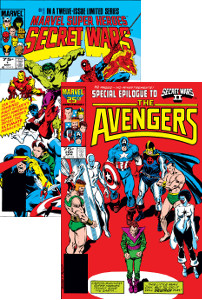 Perhaps the biggest cosmic threat came from “the One from Beyond,” known more colloquially as the Beyonder. Framed between Avengers #242 & #243, half of the Avengers team participated in the so-called Secret War, as depicted in the 1984-1985 12-issue maxiseries titled Marvel Super-Heroes Secret Wars. The series proved very popular and when a 9-isssue sequel series titled Secret Wars II ran 1985-1986, most titles in Marvel participated with the crossover with stories in individual issues. The Avengers title itself intersected the Beyonder’s story with #260 & 261, and most importantly #266, which served as a coda to the whole storyline.
Perhaps the biggest cosmic threat came from “the One from Beyond,” known more colloquially as the Beyonder. Framed between Avengers #242 & #243, half of the Avengers team participated in the so-called Secret War, as depicted in the 1984-1985 12-issue maxiseries titled Marvel Super-Heroes Secret Wars. The series proved very popular and when a 9-isssue sequel series titled Secret Wars II ran 1985-1986, most titles in Marvel participated with the crossover with stories in individual issues. The Avengers title itself intersected the Beyonder’s story with #260 & 261, and most importantly #266, which served as a coda to the whole storyline.
Although the Vision and the Scarlet Witch, Hawkeye and two Hercules miniseries could be considered spinoffs titles, none were never intended to be ongoing. By 1983, however, the 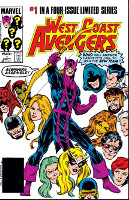 market had shown that ongoing, spinoff titles were possible when the X-Men offshoot of the New Mutants launched to success and acclaim. The following year, Roger Stern tested the waters by writing the 4-issue West Coast Avengers miniseries. The in-story impetus for west coast branch of the Avengers emerged from a story from the main Avengers title in which the Vision began experiencing erratic, controlling behavior as a result of his connection to the supercomputer on Titan. The miniseries featured Hawkeye, his new wife Mockingbird, the Jim Rhodes Iron Man, Tigra and Wonder Man. The series was deemed a success and the ongoing West Coast Avengers series debuted in October 1985 with the same cast, the only exception being that Tony Stark was now Iron Man, having returned to the role in his own book.
market had shown that ongoing, spinoff titles were possible when the X-Men offshoot of the New Mutants launched to success and acclaim. The following year, Roger Stern tested the waters by writing the 4-issue West Coast Avengers miniseries. The in-story impetus for west coast branch of the Avengers emerged from a story from the main Avengers title in which the Vision began experiencing erratic, controlling behavior as a result of his connection to the supercomputer on Titan. The miniseries featured Hawkeye, his new wife Mockingbird, the Jim Rhodes Iron Man, Tigra and Wonder Man. The series was deemed a success and the ongoing West Coast Avengers series debuted in October 1985 with the same cast, the only exception being that Tony Stark was now Iron Man, having returned to the role in his own book.
Writing the new West Coast Avengers title was veteran Avengers scribe Steve Englehart, who loved to delve into Marvel continuity for stories. In his second year, Englehart wrote the 8-part 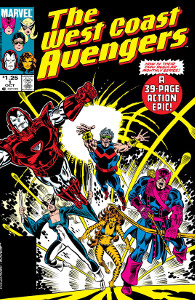 “Lost in Space-Time” storyline in which the Avengers found themselves trapped in the past with a time machine that could only go further backwards. During the sprawling tale, Englehart would touch on the western heroes of 1950s Marvel (then called Timely or Atlas) and have the heroes traipse through previously published stories from the Fantastic Four and Doctor Strange books. It was also during this storyline that Englehart would make the most dedicated attempt to redeem Hank Pym, taking the character to his lowest point, including attempting suicide, and then rebuild him. By the end of the tale, Hank Pym returned to being a superhero, this time simply called “Doctor Pym” and using his access to his “Pym particles” to miniaturize gadgets that he would keep in his multi-pouched jumpsuit. Additionally, by the end of this story, an unlikely new member would join in the form of the traditionally solo adventurer Moon Knight. Englehart would write the title for a little over three years, leaving after #41 in February 1989.
“Lost in Space-Time” storyline in which the Avengers found themselves trapped in the past with a time machine that could only go further backwards. During the sprawling tale, Englehart would touch on the western heroes of 1950s Marvel (then called Timely or Atlas) and have the heroes traipse through previously published stories from the Fantastic Four and Doctor Strange books. It was also during this storyline that Englehart would make the most dedicated attempt to redeem Hank Pym, taking the character to his lowest point, including attempting suicide, and then rebuild him. By the end of the tale, Hank Pym returned to being a superhero, this time simply called “Doctor Pym” and using his access to his “Pym particles” to miniaturize gadgets that he would keep in his multi-pouched jumpsuit. Additionally, by the end of this story, an unlikely new member would join in the form of the traditionally solo adventurer Moon Knight. Englehart would write the title for a little over three years, leaving after #41 in February 1989.
It was two years after the launch of the West Coast Avengers ongoing title that the Avengers franchise would get its next spinoff. Team leader Hawkeye had always been a popular character 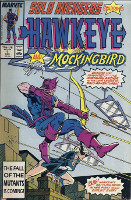 but had never enjoyed his own series, with the exception of a 4-issue miniseries five years before. In December 1987, the title “Solo Avengers” debuted. Although it technically starred Hawkeye, the series actually harkened back to the old multi-character, shared books of the mid-1960s. In each issue of the 22-page book, the first eleven pages would be dedicated to a solo Hawkeye story, with the second eleven pages depicting a solo story with a different Avenger. The character depicted was as likely a former Avenger as a current member of the team. This allowed characters unable to maintain their own title or miniseries a chance to shine. Likewise, this second story was usually written and drawn by different people each issue, allowing creators a chance of their own.
but had never enjoyed his own series, with the exception of a 4-issue miniseries five years before. In December 1987, the title “Solo Avengers” debuted. Although it technically starred Hawkeye, the series actually harkened back to the old multi-character, shared books of the mid-1960s. In each issue of the 22-page book, the first eleven pages would be dedicated to a solo Hawkeye story, with the second eleven pages depicting a solo story with a different Avenger. The character depicted was as likely a former Avenger as a current member of the team. This allowed characters unable to maintain their own title or miniseries a chance to shine. Likewise, this second story was usually written and drawn by different people each issue, allowing creators a chance of their own.
For most of its run, the “A” Hawkeye story was written by Tom DeFalco, Howard Mackie, Dwayne McDuffie and Steve Gerber. Near the end of the series, the Hawkeye story was dropped altogether and the title effectively became a 22-page solo story for the starring character in question. By this time, the name of the title had actually changed and in doing so more accurately reflected the story within. For the first 20 issues of the title’s publication, it had been called “Solo Avengers.” With #21 in August 1989, the name changed to “Avengers Spotlight,” a name it kept until its cancelation with #40 in January 1991. The name change was most likely due to an attempt to “group” like-titles on the shelf of comic shops. By putting “Avengers” first and the corresponding adjective afterward, Avengers Spotlight could now be found on the shelf right next to Avengers and the new name for the West Coast Avengers title – “Avengers West Coast.” The change from WCA to AWC occurred with #47 of that title in September 1989, a month after the Solo/Spotlight change.
Back in the “main” Avengers title, Roger Stern continued to shake things up. Although Namor, the Sub-Mariner had been one of the earliest foes of the Avengers (as far back as #3), he had more times than not proved a hero, albeit one on his own terms. Still, when Captain America himself suggested that he become an Avenger in #262, Namor accepted. Unfortunately, the general public was not as happy about the choice and Namor’s old attacks on the surface world came back to haunt him. Ultimately, his tenure with the team would prove short-lived, not due to public outcry but due to love. During a joint mission with Alpha Flight, Namor again came across the aquatic Alphan called Marrina. At the end of their adventure, Namor quit the Avengers to aid her in her time of need. [Avengers (1st series) #272]
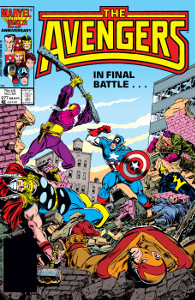 Although it did not have an official, overarching name in the issues in which it was published, the storyline begun in Avengers #273 has since been dubbed “Under Siege” in collected volumes. In the story, which had been foreshadowed in the issues leading up to it, Baron Helmut Zemo (son of the long deceased Avengers’ foe) put together a new Masters of Evil but with a twist. Instead of a small number of villains, equal to or fewer than the Avengers, this Zemo’s Masters of Evil numbered seventeen and their plan was to divide and conquer each Avenger individually using overwhelming force. By the time of the story’s conclusion in #277, the Avengers had prevailed but the victory had been pyrrhic. Hercules was out of commission, nearly beaten to death. The team’s butler, Edwin Jarvis, was tortured and almost crippled. The mansion itself was demolished, forcing the team to abandon it for the first time in its history. They would subsequently move to Hydrobase, a floating island owned by their ally, Stingray.
Although it did not have an official, overarching name in the issues in which it was published, the storyline begun in Avengers #273 has since been dubbed “Under Siege” in collected volumes. In the story, which had been foreshadowed in the issues leading up to it, Baron Helmut Zemo (son of the long deceased Avengers’ foe) put together a new Masters of Evil but with a twist. Instead of a small number of villains, equal to or fewer than the Avengers, this Zemo’s Masters of Evil numbered seventeen and their plan was to divide and conquer each Avenger individually using overwhelming force. By the time of the story’s conclusion in #277, the Avengers had prevailed but the victory had been pyrrhic. Hercules was out of commission, nearly beaten to death. The team’s butler, Edwin Jarvis, was tortured and almost crippled. The mansion itself was demolished, forcing the team to abandon it for the first time in its history. They would subsequently move to Hydrobase, a floating island owned by their ally, Stingray.
Following Roger Stern’s departure in #287, authorship of the book alternated between Ralph Macchio and Walter Simonson. Both writers depicted a period of instability within the team. Namor returned briefly in a story in which Marrina’s alien nature got the better of her, turning her into the monstrous Leviathan. To the Black Knight’s horror, Namor used the Knight’s “Ebony Blade” to end her life, unleashing its long-feared curse. Additionally, the team’s newest recruit, Dr. Druid, who had aided the Avengers during Zemo’s siege of the mansion, fell under the mind control of the villainess Terminatrix and apparently died while in her thrall. Having been mind-controlled herself, the whole affair left She-Hulk emotionally spent and she left as well. This effectively left Thor the only remaining Avenger, a literal one-man team.
 However, as had been the past, the sweeping away of characters brought the opportunity for bringing in new. Over in the X-Titles, storylines running through New Mutants and X-Factor had brought about the Inferno, in which Manhattan experienced an invasion of demons from the dimension of Limbo. In his own book, Steve Rogers had given up the mantle of Captain America and adopted the new identity of the Captain. Avengers #298-300 depicted Cap’s return to New York in the middle of the Inferno invasion and followed the event from his point of view, along with that of Jarvis, Thor and half of the Fantastic Four, Mister Fantastic and the Invisible Woman. At the end of the invasion, the Captain proposed reforming the Avengers and all agreed, as did visiting ally of Thor, an Eternal previously known as “the Forgotten One,” but who would now take up the name of Gilgamesh.
However, as had been the past, the sweeping away of characters brought the opportunity for bringing in new. Over in the X-Titles, storylines running through New Mutants and X-Factor had brought about the Inferno, in which Manhattan experienced an invasion of demons from the dimension of Limbo. In his own book, Steve Rogers had given up the mantle of Captain America and adopted the new identity of the Captain. Avengers #298-300 depicted Cap’s return to New York in the middle of the Inferno invasion and followed the event from his point of view, along with that of Jarvis, Thor and half of the Fantastic Four, Mister Fantastic and the Invisible Woman. At the end of the invasion, the Captain proposed reforming the Avengers and all agreed, as did visiting ally of Thor, an Eternal previously known as “the Forgotten One,” but who would now take up the name of Gilgamesh.
Change was indeed in the air. In short order, Steve Rogers reclaimed the mantle of Captain America. [Avengers (1st series) #301] Additionally, the tenure of Mister Fantastic and the Invisible Woman was short, as they returned to the Fantastic Four. [Avengers (1st series) #305] Their departure coincided with the addition of a new Avenger, the cosmic adventurer known as Quasar. Shortly after he joined the team in the summer of 1989, Quasar would get his own title in October of that year. It would run for 60 issues, ending in 1994.
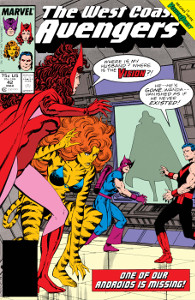 After the departure of Steve Englehart from West Coast Avengers, the title was given to famed writer/artist John Byrne with #42 in March 1989. Byrne wasted no time in shaking things up and his first story was called “VisionQuest,” which picked-up on Roger Stern’s storyline years before when the Vision grew power-mad after being corrupted by the Titan supercomputer. Feared by the governments of the world, the Vision was kidnapped, disassembled and had his memory wiped. Although he was reassembled, the Vision was drastically different. His red skin hue was now the palest white and he no longer possessed Wonder Man’s brainwaves, resulting in a cold, purely logical personality. This would be the new status quo for the Vision and would last for nearly a decade.
After the departure of Steve Englehart from West Coast Avengers, the title was given to famed writer/artist John Byrne with #42 in March 1989. Byrne wasted no time in shaking things up and his first story was called “VisionQuest,” which picked-up on Roger Stern’s storyline years before when the Vision grew power-mad after being corrupted by the Titan supercomputer. Feared by the governments of the world, the Vision was kidnapped, disassembled and had his memory wiped. Although he was reassembled, the Vision was drastically different. His red skin hue was now the palest white and he no longer possessed Wonder Man’s brainwaves, resulting in a cold, purely logical personality. This would be the new status quo for the Vision and would last for nearly a decade.
Byrne also picked-up on the logical conclusion of the Vision having previously possessed Wonder Man’s brainwaves. If they both possessed the same brainwaves, 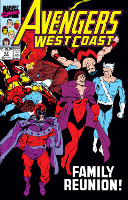 then they shared similar tastes and tendencies. If this were the case, then would not whatever caused the Vision to fall in love with the Scarlet Witch also affect Wonder Man as well? The end result of this question led to the revelation that Wonder Man had secretly been in love with the Scarlet Witch for years, a story point that would be explored by many writers over the following decades. Wonder Man’s refusal to allow his brainwaves to be copied again further led the Scarlet Witch down the path of a mental breakdown. This breakdown reached a high point when it was learned that the twin children she had bore to the Vision years before were not real at all, but a highly sophisticated manifestation of her own psychosis.
then they shared similar tastes and tendencies. If this were the case, then would not whatever caused the Vision to fall in love with the Scarlet Witch also affect Wonder Man as well? The end result of this question led to the revelation that Wonder Man had secretly been in love with the Scarlet Witch for years, a story point that would be explored by many writers over the following decades. Wonder Man’s refusal to allow his brainwaves to be copied again further led the Scarlet Witch down the path of a mental breakdown. This breakdown reached a high point when it was learned that the twin children she had bore to the Vision years before were not real at all, but a highly sophisticated manifestation of her own psychosis.
It was around this time that Iron Man rejoined the west coast branch, although he did not do so without controversy. At the time, Tony Stark had conducted his personal Armor Wars, neutralizing tech that had been stolen from him years before, and in doing so had branded his alter ego (supposedly his bodyguard) a criminal. For the first time in years, Tony Stark had to operate as Iron Man without confirming his identity to his teammates, refusing to confirm or deny who was beneath the armor. Also joining the team was the USAgent, whose true identity was likewise unclear. When Steve Rogers had given up being Captain America, the role was given to a man named John Walker. When Walker proved an unfit replacement, he relinquished the identity back to Rogers and was then apparently assassinated. In fact, the assassination had been a ruse and Walker once again served his country under this new identity and the Avengers were obligated to take him in per government request.
A few months after he had taken over the West Coast Avengers title, Byrne was given control over the original, east coast title as well, beginning with #305. Since he wrote both titles, Byrne allowed  a lot more interaction between both east and west coast branches, with west coast team’s characters making appearances in the east coast team’s title. Both books also participated in the Avengers-centric “Acts of Vengeance” storyline, in which Loki tricked several supervillains into orchestrating mischief for many of the world’s heroes. In that story, Hydrobase (which had been redubbed “Avengers Island”) was sunk, after which the Avengers would return to their Manhattan site. It’s also interesting to note that, after coming close in the past, Spider-Man finally became an Avenger, though by the end of the adventure both Captain America and the wall-crawler came to the conclusion that it was not a good fit. Still, Spidey would eventually become an official reservist soon thereafter. [Avengers (1st series) #314-318, 329]
a lot more interaction between both east and west coast branches, with west coast team’s characters making appearances in the east coast team’s title. Both books also participated in the Avengers-centric “Acts of Vengeance” storyline, in which Loki tricked several supervillains into orchestrating mischief for many of the world’s heroes. In that story, Hydrobase (which had been redubbed “Avengers Island”) was sunk, after which the Avengers would return to their Manhattan site. It’s also interesting to note that, after coming close in the past, Spider-Man finally became an Avenger, though by the end of the adventure both Captain America and the wall-crawler came to the conclusion that it was not a good fit. Still, Spidey would eventually become an official reservist soon thereafter. [Avengers (1st series) #314-318, 329]
Unfortunately, this synergy between the two titles would end with the departure of Byrne after only twelve issues. Although he had obviously been building to some greater storyline involving Immortus in the Avengers West Coast book, Byrne would not finish it. He left the title with #47, following a creative dispute with the book’s editors. The departure left editors scrambling and the book was soon given to another veteran Avengers writer Roy Thomas, who continued to write the book up until right before its cancelation.
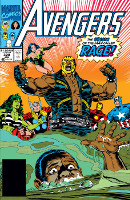 The same editorial disagreement that led to his leaving the Avengers West Coast title caused him to depart the core Avengers title as well. Taking up the slack from Byrne’s departure was Fabian Nicieza, Mark Gruenwald and then Larry Hama. Known best for his work on G.I. Joe, Hama’s run on Avengers was short, running #226-233. Nevertheless, during that short time, he introduced the new member (and character) of Rage, had a reformed Sandman join the team and gave the Avengers a new U.N. charter. After a few guest-written issues, Bob Harris would take over the book with #343 and would write it for the next four years until #395.
The same editorial disagreement that led to his leaving the Avengers West Coast title caused him to depart the core Avengers title as well. Taking up the slack from Byrne’s departure was Fabian Nicieza, Mark Gruenwald and then Larry Hama. Known best for his work on G.I. Joe, Hama’s run on Avengers was short, running #226-233. Nevertheless, during that short time, he introduced the new member (and character) of Rage, had a reformed Sandman join the team and gave the Avengers a new U.N. charter. After a few guest-written issues, Bob Harris would take over the book with #343 and would write it for the next four years until #395.
Around this time, another longtime Avenger received his own title – Wonder Man. Launching in September 1991, Wonder Man was written by Gerard Jones for its entire 29-issue run. During that time, Jones would put Wonder Man through one crisis after another, the greatest of which was during a cosmic adventure with the Avengers.
By the time Bob Harris took over the core Avengers title, the Avengers as a franchise was arguably at its then-height. Aside from the two main Avengers and Avengers West Coast titles, 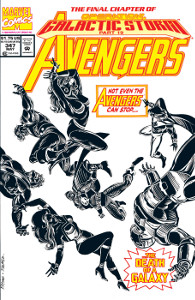 longtime members Iron Man, Thor and Captain America had long enjoyed their own books. Although with not as long a record of publication, Quasar and Wonder Man had their own titles as well. All seven series would participate in the first multi-title, maxi-issue, Avengers crossover running in the early months of 1992 – Operation: Galactic Storm. The combined brainchild of Mark Gruenwald, Bob Harris and Fabian Nicieza, Operation: Galactic Storm was to be a nod to the decades-old Kree-Skrull War, this time with Earth in the middle of conflict between the galactic empires of the Kree and the Shi’ar. The 19-issue crossover would weave between every published comic that starred an Avenger. By the end of the story, the Kree Empire was devastated by the “Nega-bomb” and had been occupied by Shi’ar forces. Almost a casualty of the war himself, Wonder Man’s powers were now out of control and would affect him for years to come. For the Avengers as a whole, they were deeply divided when half of their team, upon learning that the devastation of his own people was the deliberate work of the Supreme Intelligence, journeyed to the former Kree homeworld and killed it.
longtime members Iron Man, Thor and Captain America had long enjoyed their own books. Although with not as long a record of publication, Quasar and Wonder Man had their own titles as well. All seven series would participate in the first multi-title, maxi-issue, Avengers crossover running in the early months of 1992 – Operation: Galactic Storm. The combined brainchild of Mark Gruenwald, Bob Harris and Fabian Nicieza, Operation: Galactic Storm was to be a nod to the decades-old Kree-Skrull War, this time with Earth in the middle of conflict between the galactic empires of the Kree and the Shi’ar. The 19-issue crossover would weave between every published comic that starred an Avenger. By the end of the story, the Kree Empire was devastated by the “Nega-bomb” and had been occupied by Shi’ar forces. Almost a casualty of the war himself, Wonder Man’s powers were now out of control and would affect him for years to come. For the Avengers as a whole, they were deeply divided when half of their team, upon learning that the devastation of his own people was the deliberate work of the Supreme Intelligence, journeyed to the former Kree homeworld and killed it.
For many that read the Avengers title for the next several years, what is remembered best of this era are the “jackets” suddenly worn by most of the team. However, many more significant plot points were featured, such as the gradual re-humanizing of the Vision. During the “Gatherer” storyline, the Vision’s consciousness was placed in the body of an alternate version of himself that still maintained his red-hued skin, returning him to his more “classic” look.
